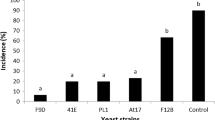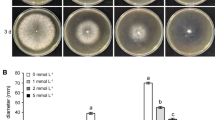Abstract
Recombinant Pichia pastoris yeasts expressing cecropin A (GS115/CEC), was evaluated for the control of the blue mold of apple caused by Penicillium expansum due to cecropin A peptide’s effective antimicrobial effects on P. expansum spores by the thiazolyl blue (MTT) assay. Then, the protein concentration was determined and it was expressed at high levels up to 14.2 mg/L in the culture medium. Meanwhile, the population growth was assayed in vivo. The population growth of recombinant strain GS115/CEC was higher than that of non-transformed strain GS115 in red Fuji apples wounds. Recombinant yeast strains GS115/CEC significantly inhibited growth of germinated P. expansum spores in vitro and inhibited decay development caused by P. expansum in apple fruits in vivo when compared with apple fruits inoculated with sterile water or the yeast strain GS115/pPIC (plasmid pPIC9k transformed in GS115). This study demonstrated the potential of expression of the antifungal peptide in yeast for the control of postharvest blue mold infections on pome fruits.



Similar content being viewed by others
References
He D, Zheng X, Yin Y, Sun P, Zhang H (2003) Yeast application for controlling apple postharvest diseases associated with Penicillium expansum. Bot Bull Acad Sinica (Taipei) 44:211–216
Leibinger W, Breuker B, Hahn M, Mendgen K (1997) Control of postharvest pathogens and colonization of the apple surface by antagonistic microorganisms in the field. Phytopathology 87:1103–1110
Gholamnejad J, Etebarian HR (2009) Effect of calcium chloride on the biocontrol efficacy of two antagonistic yeasts against Penicillium expansum on apple fruit. Phytoparasitica 37:255–261
Droby S (2006) Improving quality and safety of fresh fruits and vegetables after harvest by the use of biocontrol agents and natural materials. Acta Hortic 709:45–51
Spotts RA, Cervantes LK (1986) Populations, pathogenicity and benomyl resistance of Botrytis spp., Penicillium spp. and Mucor piriformis in packinghouses. Plant Dis 70:106–108
Janisiewicz WJ, Bastos Pereira I, Almeida MS, Roberts DP, Wisniewski M, Kurtenbach E (2008) Improved biocontrol of fruit decay fungi with Pichia pastoris recombinant strains expressing Psd1 antifungal peptide. Postharvest Biol Technol 47:218–225
Stockwell VO, Stack JP (2007) Using Pseudomonas spp for integrated biological control. Phytopathology 97:244–249
Yu T, Chen JS, Chen RL, Huang B, Liu DH, Zheng XD (2007) Biocontrol of blue and gray mold diseases of pear fruit by integration of antagonistic yeast with salicylic acid. Int J Food Micribiol 116:339–345
Jones RW, Prusky D (2002) Expression of an antifungal peptide in Saccharomyces: a new approach for biological control of the postharvest disease caused by Colletotrichum coccodes. Phytopathology 92:33–37
Florack D, Allefs S, Bollen R, Bosch D, Visser B, Stiekema W (1995) Expression of giant silkmoth cecropin B genes in tobacco. Transgenic Res 4:132–141
Wisniewski ME, Bassett CL, Artlip TS, Janisiewicz WJ, Norelli JL, Droby S (2005) Overexpression of a peach defensin gene can enhance the activity of post harvest biocontrol agents. Acta Hortic 682:1999–2005
Janisiewicz WJ (1998) Biocontrol of postharvest diseases of temperate fruits. Challenges and opportunities. In: Boland GJ, Kuykendall LD (eds) Plant–microbe interactions and biological control. Marcel Dekker, Inc., New York, pp 171–198
Kim SR, Hong MY, Park SW, Choi KH, Yun EY, Goo TW, Kang SW, Suh HJ, Kim I, Hwang JS (2010) Characterization and cDNA cloning of a cecropin-like antimicrobial peptide, papiliocin, from the swallowtail butterfly, Papilio xuthus. Mol Cells 29:419–423
Steiner H, Hultmark D, Engstrom A, Bennich H, Boman HG (1981) Sequence and specificity of two antibacterial proteins involved in insect immunity. Nature 292:246–248
Hultmark D, Steiner H, Rasmuson T, Boman HG (1980) Insect immunity: purification and properties of three inducible bactericidal proteins from hemolymph of immunized pupa of Hyalophora cecropina. Eur J Biochem 106:7–16
Hultmark D, Engstrom A, Bennich H, Kapur R, Boman HG (1982) Insect immunity: isolation and structure of cecropin D and four minor antibacterial components from Cecropia pupae. Eur J Biochem 127:207–217
Hakan S, Andreu D, Merrifield RB (1988) Binding and action of cecropin and cecropin analogues: antibacterial peptides from insects. Biochim Biophys Acta 939:260–266
Jin FL, Xu XX, Zhang WQ, Gu DX (2006) Expression and characterization of a housefly cecropin gene in the methylotrophic yeast, Pichia pastoris. Protein Express Purif 49:39–46
Cereghino JL, Cregg JM (2000) Heterologous protein expression in the methylotrophic yeast Pichia pastoris. FEMS Microbiol Rev 24:45–66
Li L, Wang JX, Zhao XF, Kang CH, Liu N, Xiang JH, Li FH, Sueda S, Kondo H (2005) High level expression, purification, and characterization of the shrimp antimicrobial peptide, Ch-penaeidin, in Pichia pastoris. Protein Express Purif 39:144–151
Somboonwiwat K, Marcos M, Tassanakajon A, Klinbunga S, Aumelas A, Romestand B, Gueguen Y, Boze H, Moulin G, Bachere E (2005) Recombinant expression and anti-microbial activity of anti-lipopolysaccharide factor (ALF) from the black tiger shrimp Penaeus monodon. Dev Comp Immunol 29:841–851
Liu X, Wang LP, Li YC, Li HY, Yu T, Zheng XD (2009) Antifungal activity of thyme oil against Geotrichum citri-aurantii in vitro and in vivo. J Appl Microbiol 107:1450–1456
Wang YF, Tang F, Xia JD, Yu T, Wang J, Azhati R, Zheng XD (2011) A combination of marine yeast and food additive enhances preventive effects on postharvest decay of jujubes (Zizyphus jujuba). Food Chem 125:835–840
Quaglia M, Ederli L, Pasqualini S, Zazzerini A (2011) Biological control agents and chemical inducers of resistance for postharvest control of Penicillium expansum Link on apple fruit. Postharvest Biol Technol 59:307–315
Xu XX, Jin FL, Yu XQ, Ji SX, Wang J, Cheng HX, Wang C, Zhang WQ (2007) Expression and purification of a recombinant antibacterial peptide, cecropin, from Escherichia coli. Protein Express Purif 53:293–301
Morales H, Marin S, Ramos AJ, Sanchis V (2010) Influence of post-harvest technologies applied during cold storage of apples in Penicillium expansum growth and patulin accumulation: a review. Food Control 21:953–962
Guetsky R, Elad Y, Shtienberg D, Dinoor A (2002) Establishment, survival and activity of the biocontrol agents Pichia guilermondii and Bacillus mycoides applied as a mixture on strawberry plants. Biocontrol Sci Technol 12:705–714
Lahlali R, YEl Hamadi, Guilli M, Jijakli MH (2011) Efficacy assessment of Pichia guilliermondii strain Z1, a new biocontrol agent, against apple blue mould in Morocco under the influence of temperature and relative humidity. Biol Control 56:217–224
Santos A, Marquinq D (2004) Kiler toxin of Pichia membranefaciens and its possible use as a biocontrol agent against mould diseases of grapevine. Microbiology 150:2527–2534
Zong YY, Liu J, Li BQ, Qin GZ, Ti SP (2010) Effects of yeast antagonists in combination with hot water treatment on postharvest diseases of tomato fruit. Biol Control 54:316–321
Druvefors U, Jonsson N, Boysen ME, Schnurer J (2002) Efficacy of the biocontrol yeast Pichia anomala during long-term storage of moist feed grain under different oxygen and carbon dioxide regimens. FEMS Yeast Res 2:304–389
Acknowledgments
This research was partially supported by the Foundation for the Author of National Excellent Doctoral Dissertation of People’s Republic of China (201061), the Program for Key Innovative Research Team of Zhejiang Province (2009R50036), the Ph.D. Programs Foundation of Ministry of Education of China (20090101120079, 20100101110087), the Open Foundation from Top Key Discipline of Modern Agricultural Biotechnology and Biological Control of Crop Diseases in Zhejiang Provincial Colleges (2010KFJJ006), the National Natural Science Foundation of China (20906060), Open Project Program for Key Laboratory of Fermentation Engineering (Ministry of Education) (2009KFJJ02), and the Fundamental Research Funds for the Central Universities.
Author information
Authors and Affiliations
Corresponding authors
Rights and permissions
About this article
Cite this article
Ren, X., Kong, Q., Wang, H. et al. Control of apple blue mold by Pichia pastoris recombinant strains expressing cecropin A. Bioprocess Biosyst Eng 35, 761–767 (2012). https://doi.org/10.1007/s00449-011-0656-2
Received:
Accepted:
Published:
Issue Date:
DOI: https://doi.org/10.1007/s00449-011-0656-2




